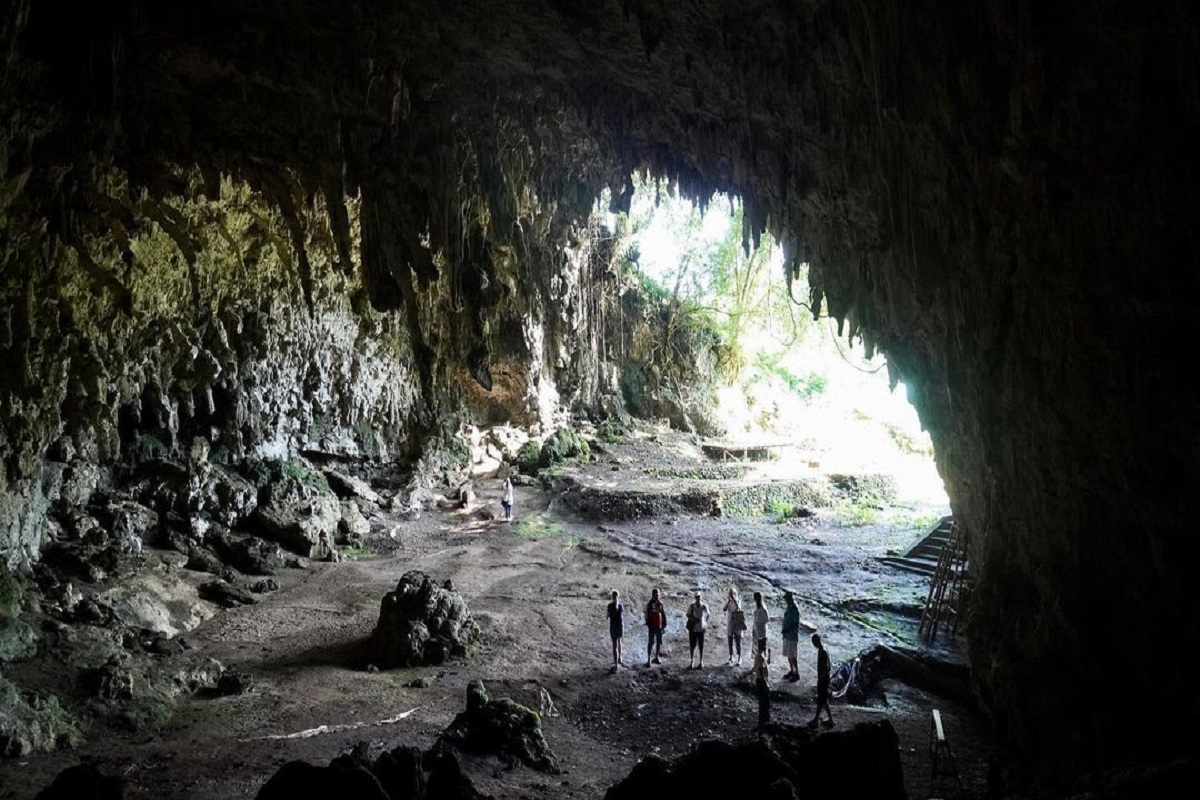LIANG BUA CAVE

In 2003, an disciplinary team of Indonesian and Australian archaeologists, geologists and paleoanthropologists made a spectacular discovery at Liang Bua (which means “cold cave” in the local language), a lime stone cave in the Manggarai district. They excavated a skeleton a very small stature, the size of a 3-year old child, 160 cm in height, with a brain volume less than a third of a modern person’s. The tiny adult female skeleton, which resembled fossils dating more than 3 million years ago, turned out to have lived only 18,000 years ago, when modern humans already existed.
It seemed to represent a new kind of human species: the Homo Floresiensis. With this finding, long-held scientific theories on the evolutionary past of human beings were being contested: was there a land connection between mainland Asia or Australia and Flores? Was the isolated island situation responsible for the dwindling size? Did modern human beings cross the hobbit, or has volcano eruption set an end to the hobbit population before modern human beings settled on Flores? Is it really a new kind of human being, or did it suffer from a disease causing drawrfism? The Homo Florensiensis is subject to many speculations. Even though a lot of scientific research has been done, there is no clear answer to these questions yet.
Father Verhoeven, a Catholic missionary of the S.V.D. order, was the first, to undertake archaeological excavation in Liang Bua. When he and his archaeological team visited the cave for the first time in 1965, it was still being used as a local elementary school. Among Father Verhoeven’s excavation outputs were mainly pottery and stone artefacts, which seemed to prove that Liang Bua was inhabited by humans in the past. After Verhoeven, more researches by Indonesian archaeologists was undertaken, confirming the assumption of human occupation. Archaeological excavation is still going on, with further discoveries of the bony remains of stegodons, varans, rats, birds, and stone artefacts.
Old Manggaraian myths and tales about small people living in caves are still doing the rounds. Further research may bring to light whether the ancestors of the Manggaraian people really have met the hobbit in a not so long past gone.
Lingko – An agricultural heritage

Long before the wet rice cultivation, the ancestors of the Manggaraian people grew dry rice, corn, and tubers in the lingko fields. With their round spider-web structured shape, these pieces of land are a unique eye-catcher in Manggarai. In the past, every village used to own several lingko fields. During planting and harvesting time, ceremonies and ritual offerings were held at the lodok, the ritual center of the lingko. The lodok features a wooden pole and a rock. These two objects symbolize the reunion of the male and female, the heaven and earth, and the creation of mankind.
If a new lingko was opened, the sacrifice of a water buffalo was required. The division of a new lingko was guide by the tu’a teno, the Lord of the Land. This traditional leader had the authority over the land the rituals and ceremonies related to the agricultural cycle. The distribution of the fields to different families was carried out at the lodok. Every family of a community had the right to work a certain piece of land. Depending on the family’s size, the head or the family held a certain number of fingers to the pole in the lodok. The distance between the fingers was marked on this pole. From these two points, lines were drawn to the outer circle of the lingko, defining the size of a family’s land. These pieces of pie segments were called moso, which means ‘hand’ in Manggarai language.
The moso were not conceived as the private property of single person or households. Because traditionally the lingko was farmed with a system of shifting cultivation, claims of constant land tenure were not yet common. After a two-year utilization period, the old fields were given up, and virgin forest – which in the past was abundant – or former fallow land, was cleared for new fields. Even though these fields are still existent today, their agricultural and ritual context has changed drastically. Nowadays the lingko fields are primarily used for wet rice cultivation. With the dominance of this new form of farming, the significance of the traditional agricultural calendar with its rituals and ceremonies embedded in the planting and harvesting of dry rice and corn has also faded.
Itinerary:
Start and end: Labuan Bajo
Liang Bua Cave & Lingko – An agricultural Heritage Day Trip
Breakfast at your Hotel in Labuan Bajo. After breakfast drive to visit Liang Bua Cave it is about 5 hours from Labuan Bajo. Arrive at Liang Bua Cave, seeing the beauty and uniqueness of Homo Floresiensis. Afterwards drive back to Ruteng for lunch. After lunch drive to visit Lingko – An agricultural heritage. Drive back to Labuan Bajo. Arrive in Labuan Bajo drop you off at your Hotel. End of service.
Price Include: Private AC car, driver and petrol, English Speaking Tour Guide and Guide fee, All entrance fee, lunch, Unlimited mineral water during tour, Tour as per the itinerary.
Price Exclude: Personal expenses, Alcoholic and soft drinks, Personal travel insurance, International/domestic airfare, Etc.
Share
